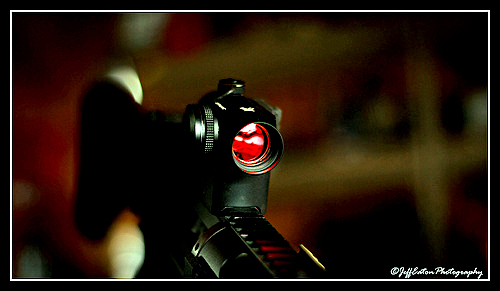Vortex Sparc vs Strikefire — What They Have in Common
First off, they are both red dot optics. Both are 1-power optics and are designed for close range shooting. Both are backed by the same Vortex VIP lifetime warranty, and both are suited for modern carbines.
When it comes to price, it’s basically the same and should not be a factor. Both dots are similar in quality and are both overall excellent options.. Both optics are waterproof, not just water-resistant, but completely submersible. Both optics are nitrogen-purged for fog-free performance and are also shock proof.
Vortex Sparc vs Strikefire — Reticles
Both are considered red dot scopes, but that’s a catch-all term for optics like this, and often the dot might not be red at all.
The Strikefire (see full specs) actually has two options for reticles. The first is a single red dot that has a super bright option. The next is the ability to swap between red or green reticles but is not as bright as the standard red. The additional of a green reticle allows the user to use the dot against a wider variety of background surfaces, and green also generally creates less eye strain.
The Sparc, on the other hand, only has the option for a red dot.
The optics also differ in reticle size. The Strikefire is a larger more eye catching 4 MOA, and the Sparc (see full specs) has a smaller, more precise 2 MOA. This is one of those choices the end user will have to make for themselves. Both optics feature ten different brightness levels with the Strikefire having the edge in brightness.
Vortex Sparc vs Strikefire — Size
However, the biggest difference between the two red dots is external. The Strikefire and Sparc are quite different in size.
The Strikefire is a 30mm tube and objective lens. The Strikefire is also longer to allow the mounting of a cantilever. The Strikefire actually comes with a cantilever that will allow you to co-witness with standard height AR sights. The optic is 5.6 inches long and about an inch and a half in height.
The Sparc is more of a micro-optic. With 22mm objective lens and a compact frame, the little optic doesn’t have room for any kind of mounting system. The small optic mounts with a lower Picatinny/Weaver adapter. The Sparc is 3.1 inches long and only 1.1 inches high.
There isn’t a significant weight difference, but it is worth mentioning that the Strikefire weighs 7.2 ounces without the cantilever mount. The Sparc weighs 5.9 ounces with a mount. This isn’t a considerable difference on a rifle, but could be for other weapons.
Vortex Sparc vs Strikefire — Versatility
Both optics come with a mount so it is ready to go out of the box. The cantilever mount rises the Strikefire optic up to perfect co-witness height. The Strikefire works with any 30mm mount, and can be equipped with lower profile mounts or with quick detach mounts. This makes the optic perfect for a wider variety of rifles. The AK series, the SIG 556 series, or even the PTR 91 series would be a good fit with the Strikefire.
When it comes to versatility, the Sparc (read reviews) shines a little brighter in my opinion. The Sparc can function on a rifle, shotgun or handgun. The optic’s small size makes this possible. The Sparc comes with a mount to allow a lower ⅓ co-witness or can be directly mounted on a rail. This and the Sparc’s light weight make it appropriate for handguns and large revolvers. The Sparc could even be used with a bow and arrow if the bow has a Picatinny rail.
Both optics feature low brightness settings for use with night vision devices, a welcome touch on such affordable optics. Both optics will work with the Vortex magnifier, but the Sparc will need a specific riser. The Strikefire (read reviews) is ready to go out of the box with a magnifier.
Vortex Sparc vs Strikefire — Battery Life
Battery life on both optics is impressive. The Sparc offers a total of 300 hours of battery life when the optic is set to its maximum brightness setting and a total of 5,000 hours of battery life on the minimum setting. The Strikefire can last 400 hours on its maximum setting and can last 7,000 hours on its minimum setting.
The Strikefire has the immediate advantage here. The Strikefire uses a single CR2 battery, which is somewhat odd, but not hard to find. The CR2 is an expensive battery, though, and is most commonly found in cameras. The Sparc has less battery life, and uses a CR2032 battery, a coin type, that is also expensive, but easy to find.
Both optics do feature an automatic 12-hour shutdown switch. This is great if you’re like me and you tend to forget to switch the optic off when you’re done shooting.
Vortex Sparc vs Strikefire — Conclusion
Both Vortex optics are rather nice. The selection process for me is what I am planning to do with the optic.
If I was mounting an optic solely to a rifle, I would choose the Strikefire. The Strikefire is larger, easier to use, and the dot is more eye-catching. The fact the optic is ready to go with a magnifier and can be used with a quick detach device. The Sparc is what I’d choose if I was going to be changing the optic around on different weapons or if I was looking for a red dot for a handgun.
But, in the end, both are excellent optics, and you’d be well served with either.






